Vizsla Dog Breed Information, Pictures, and Facts
Thinking about getting a Vizsla pup? Well, there are certain things to know about the breed before you make any further decisions. Thanks to their perfect size, amazing sense of smell, and good stamina, Vizslas were once humankind’s best hunting buddies.
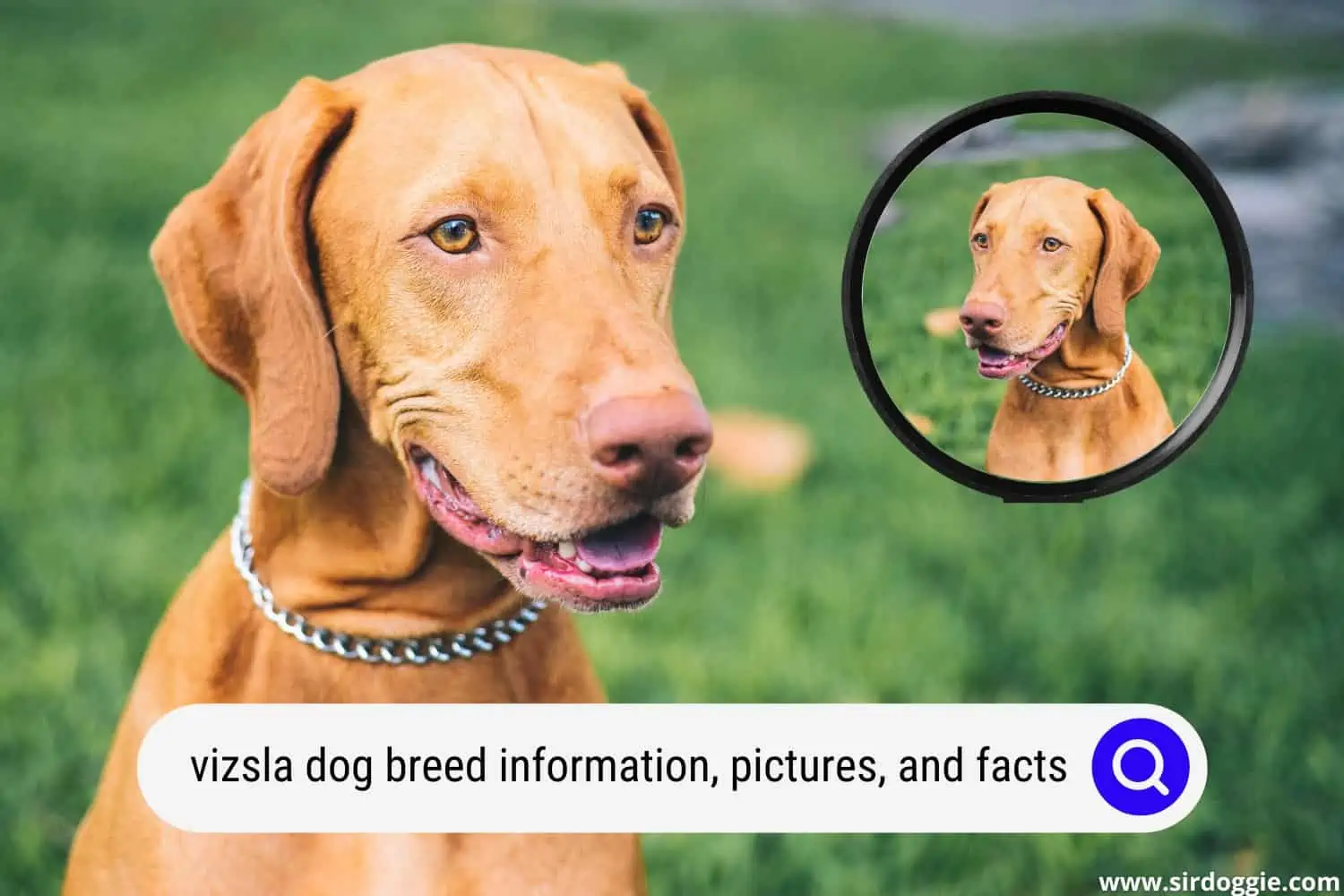
Nevertheless, today they are more commonly found snuggled up on beds and sofas beside their human companion, getting annoyed by the squirrels, and chasing sticks and birds around the park.
Irrespective of how they have incredibly transformed into good house pets, Vizsla dogs have retained their hunting instincts and characteristics, which is why they come under the hunting dog breed category.
In our Vizsla dogs handbook, we will be exploring everything about this dog breed, from the history of Vizslas to breed characteristics, personality, temperament, health, training, how to care, and a lot more.
We have designed this handbook in different sections so that it is easy for you to access information. This guide is for those who are interested in bringing home a Vizsla and want to know more about the breed. We have used our personal experience with this dog breed to create this handbook.
We hope that you will find this guide informative and engaging!
About Vizsla Dogs

Vizsla is a Hungarian dog breed that has been in the picture since the middle ages. Vizslas are known for being sensitive, warm, mannered, lively, and playful. This dog breed likes to be petted all the time, which makes them companionable and loyal. In most homes that have Vizslas, you will see them cuddling and around people all the time, especially sitting on their owners’ laps.
Vizslas are an energetic dog breed that loves outdoor activities. If you live an active life like going to parks, biking, running, jogging, hiking, or playing any sports, then Hungarian Vizsla is the perfect dog breed for you. They love playing out in the open space and doing vigorous exercises. Their popularity has been on the rise among dog lovers, and with their loyalty, athleticism, and beautiful coat, it is easy to see why.
People adore Vizslas for their affectionate, devoted nature and infectious enthusiasm for life. They are gentle and lively, but also more protective and fearless than the average hunting dog, which makes the breed a stellar watchdog.
As a Vizsla owner, you are required to help it channel some of that boundless energy. With that said, they need an open field with grass where they can safely run and play every day without any restrictions.
They learn quickly if properly rewarded with treats, affection, and praise. It is a sensitive dog breed, so you have to avoid disciplining them with loud voices and harsh actions. Vizslas are social dog breeds, hence they need to be socialized with other dogs and humans. But before you take your Vizsla pup out, make sure that it has got its vaccinations for parvovirus, distemper, and rabies, among other things.
Vizsla Dog: Vital Stats
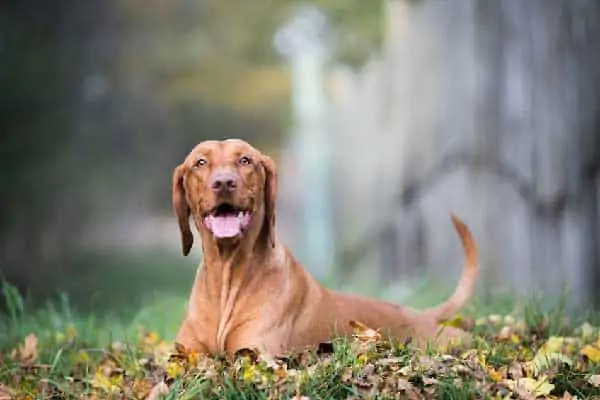
1. Vizsla General Appearance
The Vizsla is a lightly built but muscular dog breed. It has a strong and lean body that gives it speed and endurance. They look somewhat similar to Dobermans but are slightly shorter in height. They have a short and smooth coat, which is golden-rusty in color. What’s unique about the appearance of Vizsla is that its nails, eyes, and nose generally blend in with the coat/fur in terms of color.
Agile and energetic, Vizsla is a dog of power. Its attractive coat has a shiny appearance and sheds a lot less. Originating in Hungary, this breed was bred to work in water, forest, and field, keeping away any predators from the livestock, hunting rodents, and tracking wolves. They are very smart and are always alert. Vizslas benefit from lots of physical activity.
2. Vizsla Dog Breed Group
Vizslas come under the category of sporting dogs. For centuries, the breed was owned by the sporting nobility of Hungary. They boast an excellent sense of smell. And before firearms were invented, Vizslas were used to search and scent for birds and rodents that were then either caught by the dog themselves or netted.
The breed was trained to work the plains of Hungary. The breed showed its potential to its human companions by working on difficult terrains like rocks, mountains, riversides, cornfields, tall grasslands, forests, and thick crop cover. They mature early and are adept at pointing and retrieving even before they turn a year old. In the field, they stay close to their human companion and maintain a deliberate pace.
This makes them versatile hunters, and the best is that they can not only point, but retrieve on land and from water. In the field, they use their expert nose to sniff out ruffed grouse, woodcock, and pheasant. Most importantly, this dog breed has some excellent memory.
Vizslas are respected for their potential to remember and pinpoint the best routes and spots for finding rodents and birds. Today, Vizslas are more than just sporting and hunting dogs. Some are great companions to their owners; others work as drug-detection canines guide dogs, and search and rescue dogs.
3. Vizsla Dog Weight
Vizsla is a medium-sized dog breed that has a lean body. An adult male Vizsla weighs between 40 pounds and 60 pounds. On the other hand, a female Vizsla weighs around 36 pounds to 50 pounds. There are cases where Hungarian Vizslas have gotten overweight. This is because they are not given proper exercise.
4. Vizsla Dog Height
Vizslas have a lean muscular body that gives them strength and agility. This is because they have a short height. A full-grown male Vizsla stands at 22 inches to 25 inches tall, whereas a full-grown female Vizsla stands between 20 inches and 24 inches in height. In order to let them grow properly, avoid giving them strenuous exercise at the early stage. When they are a puppy, their bones are still in the growth phase.
5. Vizsla Dog Lifespan
The average lifespan of the Hungarian Vizsla is around 9 to 15 years. If given proper care, take care of their ailments, given adequate exercise and diet, their life expectancy can reach between 12 years and 15 years.
15 years is the maximum a Vizsla can live. There are no records of them surpassing this expectancy rate. It is important to check with the vet to determine what are healthy foods you can give to your Vizsla.
Vizsla Breed Characteristics
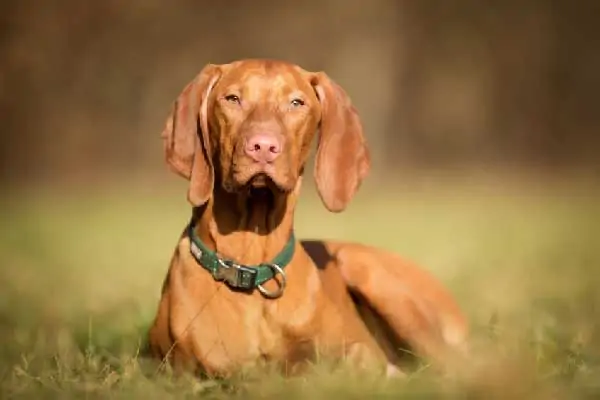
1. Vizsla Adaptability
When you are bringing home a dog or a pup, it doesn’t matter what breed, it is important to research their adaptability skills. That is, you need to determine whether the dog you are bringing in is trainable, can tolerate what type of weather is the breed sensitive to, is perfect for novice owners, and a lot more. For Vizsla lovers, here is what you need to know in terms of their adaptability levels.
2. Vizslas Adapts Well To Apartment Living?
Most people think that since it is a medium-sized breed, it can easily adapt to apartment living. But what they are missing is that Vizslas are highly energetic dogs, and living in an apartment that has calm indoors, no traffic, and low energy feeling, doesn’t make them suitable for apartment living. You need a good-sized front yard or backyard where the dog can spend most of its day chasing squirrels and frightening birds.
However, if you are sure that you can give your Vizsla at least two hours of exercise daily, you can consider having one if you live in an apartment. Unlike other hunting dogs like Beagle that are a perfect fit for apartment life, Vizslas may feel depressed and stressed with all the energy confined to them.
They need heavy exercise to release that energy. There are cases where people have reported that their Vizslas have destroyed things like chewing off the curtains, furniture, rugs, carpets, mats, etc. This destructive nature is because they need a source to release their energy.
So, the short answer to your question of whether Vizslas adapt well to apartment living is NO. Nevertheless, if you live an active life and give your Vizsla the exercise it needs on a daily basis, you can keep it in your apartment but consider finding an appropriate crate so that you can give it a little more personal space in your apartment.
3. Are Vizslas Good For Novice Owners?
If you have never owned a dog before, you should refrain from choosing Vizsla as your first dog. They are a lot of work and need training from an early age. If you can provide them with that, then there is no issue with having Vizsla.
One great aspect about Vizslas is that they are incredibly resilient. So, if you are a novice at training, the dog will easily bounce back from your mistakes and inconsistencies. But given that Vizslas are highly sensitive dog breeds, have their own independent thinking, and are assertive, they are a bit harder for first-time dog owners to manage.
You can enroll your Vizsla pup for a dog training class where it can learn the basics of living in a house with humans, among other things.
4. Vizsla Sensitivity Level?
Vizslas stand on top of the sensitivity level. They are probably the only dog breed with the highest level of sensitivity in them. Handling sensitive dogs requires special skills. If you are loud, and angry all the time, and use harsh disciplining measures, then Vizsla is not the right breed for you.
There are dogs that are highly tolerant and easy-going, and then there are Vizslas that are extremely opposite of that. They cannot handle noisy and chaotic households, nor can they handle more assertive owners. As they are themselves assertive, they need a loving home and a loving owner who can shower all the happiness to them.
They get easily stressed when you are acting more assertive towards them. In such a case, they will start disobeying you, get more aggressive, or even run away from home.
5. Can Vizslas Tolerate Being Alone?
Do you live alone? Do you have another dog at home? Is someone always home when you are not there? Vizslas cannot tolerate being alone. They bond very closely with each and every member of the family and are prone to worry or even panic if you leave them alone in the house.
Vizsla is a dog breed that loves to socialize and needs constant attention. So, it is not the right dog for you if you live alone or both you and your partner go to work, leaving the house empty. Someone must be present all the time in the house when you are not there. Vizslas love their human companions incredibly, and if you leave them alone for a while, it can grow them anxious.
An anxious dog is a destructive dog. It can be seen in their behavior. They will bark more often unnecessarily, whine a lot, and chew down everything they get their hands on, and otherwise, causing mayhem. If you own other dogs, your Vizsla can be with them when you are not there.
Other dogs can help them stay content and play with them in the backyard. Nevertheless, this breed does well when a family member is at home for the most part of the day. Or if it is possible to take your Vizsla to work, then it works the best.
6. Can Vizslas Tolerate Cold Weather?
Vizslas have a very short coat with a little undercoat and some body fat. This makes them vulnerable to harsh winters. While winters don’t bother them that much, it is the extreme cold that they cannot tolerate.
If you live in an area where winters are harsh, you must keep your Vizsla inside the majority of the time. And you should invest in good-quality sweaters and jackets for chilly walks.
During winter, you need to pay special attention to your Vizsla’s physical training. They might need excessive training during winter depending on what they eat. Lack of exercise may cause overweight issues.
7. Can Vizslas Tolerate Hot Weather?
Yes, they can tolerate hot weather given that they remain hydrated all the time and only go for walks or physical activities outside early in the morning or when the sun is setting low. While they don’t need any specialized treatment like air conditioning must be ON 24/7, you can make sure that they have a cool and composed environment either inside your house or in the backyard.
If you plan to keep your Vizsla in the backyard, prepare a house in the shade or under a tree where it can rest and play in the daytime. Make sure that the doghouse you prepare is properly ventilated. If your Vizsla stays inside, leave the fan on during hot days. You can also leave the windows open.
8. Vizsla Friendliness

The friendly temperament of the dog is an important aspect to consider when you are bringing home a new dog. When we talk about Vizslas, they get full marks in all-around friendliness. While the Hungarian Vizslas are bred to be hunting dogs and boast aggression as well, when it comes to friendliness, they are the best.
9. Are Vizslas Affectionate With Families?
As discussed earlier, Vizslas bonds incredibly well with the whole family. While they bond closely with one person from the family, they show affection to everybody in the family. Since the early ages, humans have maintained a close bond with Vizslas. This is why they feel more comfortable around humans than anything else. They will never harm your family.
10. Are Vizslas Kid-Friendly?
Vizslas are naturally friendly and gentle with children. According to some dog experts and breeders, Vizslas consider babies and infants as their own pups. However, how they behave with your kids all rely on their past experiences with children. If they are trained properly since puppyhood, they will be cautious around children. But since all dogs have sharp pointy teeth and strong jaws, they might bite in stressful situations.
11. Are Vizslas Dog Friendly?
Another great trait of the Vizsla dog breed is that it has a great temperament around other dogs. While you cannot surely say that they will behave in front of the other dogs, they will keep their distance until provoked by the other dog. Nevertheless, the breed isn’t the only factor that decides whether or not it is dog friendly. If your dog has lived with its littermates until 6-8 weeks and has spent a lot of time playing with other dogs, it is likely to have excellent canine social skills.
12. Are Vizslas Friendly Toward Strangers?
At first, they are a bit shy to welcome strangers, but when they get used to them, they will start wagging their tails. However, please note that even if Vizslas are naturally friendly with humans, it doesn’t mean that they cannot be aggressive against them. If your dog has grown among humans, it will likely be more friendly to everybody.
13. Vizsla Trainability
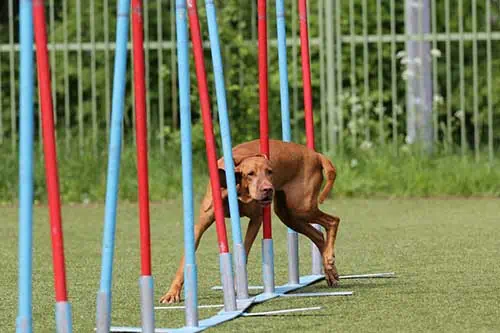
This is another aspect that makes Vizslas a popular dog breed. It is fun to train a Vizsla dog because they are all in for physical activities and outdoor fun.
14. Easy To Train?
Vizslas are one of the easiest dogs to train, especially commands like sit, come, wait, stay, etc. However, if you want them for hunting sports, special training is required, which can take some time. Overall, the Vizsla dog can easily learn commands. However, you will have to properly reward them with treats, affection, and praise. Never use loud voices or harsh actions for disciplining them. They are a sensitive breed.
15. Intelligence?
Vizsla is a dog that was bred for jobs that require concentration, intelligence, and decision-making. Therefore, they need to exercise their brain. On the other hand, Vizslas were also bred to run all day. Hence, they are required to exercise their bodies as well. Vizsla is an intelligent dog breed, and you are required to make them participate in brain functioning activities like finding treats, digging, and more.
16. Potential For Mouthiness?
Mouthiness refers to a dog’s tendency to chew, nip, and play-bite. It is most common when the dogs are just pups. Since Vizslas are hunting dogs, they have a bit of mouthy character. But they make sure that it is fairly a soft painless bite that doesn’t penetrate the skin. You can correct this behavior at the time of training.
17. Vizsla Prey Drive?
Vizslas have a high prey drive. Hungarian Vizslas were bred to hunt. Therefore, it is an inborn desire to run after and sometimes kill other smaller animals. Anything that whizzes by, like squirrels, cats, or even a car, it triggers that instinct. So, they should be leashed when you take them out for walks. And if you own other smaller pets like hamsters, rats, cats, etc., Vizslas will not blend in right.
18. Vizsla Tendency To Bark Or Howl?
All dog breeds bark and howl. It is their natural instinct. However, it can be annoying when they are unnecessarily barking. Given that your Vizsla gets proper exercise and plenty of rest, it won’t bother barking unnecessarily unless it is needed. Since they are hunting dogs, it is their natural instinct to remain silent in order to get closer to the prey.
19. Vizsla Wanderlust Potential?
Vizslas are typically wanderlust. Don’t just bring home a Vizsla, thinking that it will live with you in a confined space with ease. They need open air; they need adventure in life; they are bred to travel long distances with ease.
20. Vizsla Physical Needs
Vizsla requires high levels of physical activities to feed their energy levels. You will have to take them for long walks, hiking on long trails, and do other physical workouts suitable for them.
21. Vizsla Energy Level
Vizsla is a highly energetic dog breed that is always ready and waiting for action. You need to provide them with what they want in order to keep them content. They barely sleep during day and are active throughout the day. You will have to make them tired with high intensity activities.
22. Intensity?
Vizslas need lots of training to learn good manners. Everything they do, they do with vigor – be it straining on the leash, drinking and eating with big gulps, etc.
23. Vizsla Exercise Needs?
Vizslas need daily rigorous training else they are prone to put on weight. Since they are hunting dogs, they will not just sit around the house sleeping all the time. They will keep themselves engaged with whatever thing they find interesting, whether it is chewing down your expensive sofa or your shoes. So, if you live an inactive lifestyle, this breed isn’t for you.
24. Vizsla Potential For Playfulness?
They are extremely playful and are always begging for a game.
History of Vizsla Dogs:
The Vizsla was bred and developed in Hungary as a hunter, which was capable of retrieving and pointing. One of the most amazing facts about the Vizsla dog breed is that the dogs used to hunt in partnership with falcons. According to many historians, the Vizsla would point and scare the bird off, and the falcon then dives to bring the bird to earth.
During World War I, Vizslas also served as messenger dogs. However, the hardship of that era almost put Vizslas on the verge of extinction. World War II wasn’t that good either for the breed as they barely survived. However, people had an interest in the breed long before.
They were intrigued by the breed’s ability to find and locate things. Eventually, the breed was saved from facing extinction and given a new chance. After World War II was over, in 1950, Americans started taking an interest in Vizslas. It was in 1960 when the Vizsla dog breed was officially recognized by the American Kennel Club as its 116th breed.
Today, Vizslas has a ranking of 43 among the 155 varieties and breeds of canines recognized by the American Kennel Club. Vizslas are also among the top 10 fastest dog breeds in the world.
Vizsla Dogs Health:

Vizslas are a healthy dog breed, but like all other canine breeds, they are susceptible to certain diseases and health conditions. If you are considering having this breed, it is important to know everything about the potential health threats that these dogs face.
When buying a puppy, always consider a good breeder who can show you the health clearances of the puppy’s parents. Health clearance is important because it is proof that the dog has been tested and cleared of a specific health condition.
Make sure that the health clearances you get are from organizations like the Canine Eye Registry Foundation (CERF) which certifies that the eyes of the dogs are normal, and the Orthopedic Foundation for Animals which certifies for thyroid and hips.
On the other hand, there are some health issues that don’t appear in dogs until the dog is fully grown. So, health clearance is only provided to those dogs that are over 2 years of age. This means that the breeder you find should not be breeding the dog until they reach the age of two years or above. This is very important, especially if you are a novice dog owner.
Here are some potential health conditions that may affect Vizslas.
1. Progressive Retinal Atrophy
Vizslas are prone to getting affected by progressive retinal atrophy. This is a degenerative eye disorder that causes loss of vision in dogs. The disease deteriorates the health of the photoreceptors located at the back of the eye. In the early stages, your dog may lose its sense of sight during nights.
The disease gradually takes over the entire retina causing permanent blindness. It is important that the breeder you choose follows safe breeding practices and does not breed their dogs with this disease. The breeder is also required to have their dogs’ eyes certified every year by a vet ophthalmologist.
The best thing about dogs is that they easily adapt to being blind unless they are faced with changing or new environments. And thanks to their other senses, they can live a happy and healthy life even after vision loss.
2. Lymphosarcoma
Lymphosarcoma is a cancerous disease that is highly common in Vizsla dog breeds. It can occur anywhere in the body, such as bone marrow, liver, lymph nodes, gastrointestinal tract, and spleen.
80% of the dogs with this disease are reported to survive the condition. There are only two treatments available – either chemotherapy or surgery, after which the dog goes into remission. Those that are diagnosed early can be treated without surgery.
3. Hypothyroidism
Hypothyroidism is a condition where the thyroid gland produces abnormally low levels of hormones. In Vizslas, the symptoms of the condition include infertility, irregular heat cycles, low energy levels, drooping of the eyelids, mental dullness, and obesity.
Heavy symptoms include the skin becoming rough and dark, and the fur getting coarse and brittle. While there is no cure for the disease, it can be kept under control with regular medications that should continue throughout the dog’s life. With proper medication, the dog can live a full, healthy, and happy life. Along with medications, a special diet also needs to be followed.
4. Canine Hip Dysplasia
Canine hip dysplasia is a hereditary condition in dogs where the hip joint and thigh bone don’t fit together properly. This condition can cause extreme pain and lameness in dogs. It is difficult to notice any signs of hip dysplasia in dogs as the condition is drastic in older dogs.
With age, the dog may develop arthritis as a result of the condition. As it is a hereditary condition, don’t buy a dog whose one of the parents has hip dysplasia. The breeder should not breed a dog with hip dysplasia as the litter may also suffer from the same. Ask for the clearance certificate before you buy the dog.
The condition can worsen following environmental factors, such as falling on slick floors, injuries incurred from jumping and running, or rapid growth from a high-calorie diet.
5. Epilepsy
Epilepsy is also a hereditary condition that causes neurological seizures. It is basically a neurological disorder in dogs that can manifest in unusual behavior, fainting spells, rigidity, and dizziness.
Sometimes, it is frightening to watch as a dog dad or dog mom. While the treatment is available, there is no cure. The condition can be kept under control through medications. With proper management of the disease, your dog can live a full and healthy life.
6. Excessive drooling?
Excessive drooling in dogs may be due to dental problems, foreign bodies in the mouth, poison, heat stroke, cancer in the mouth, or a contagious disease like rabies. If your dog is drooling excessively, immediately take it to the vet and get the diagnosis done.
Other Health Issues in Hungarian Vizslas
Other health issues that your Hungarian Vizsla may experience include skin allergy, otitis externa, mass lesions, dermatitis, and wounds. Wounds may take more time to heal as this dog breed doesn’t like to sit around and rest.
Vizsla Dogs Care

To care for your Vizsla, there are four important things to remember. They are:
Vizsla Exercise
Exercise will give their muscles and brain a rush of oxygenated blood that will help them in staying healthy and fit. Moreover, daily exercise will also help in keeping their bones strong and healthy.
Vizsla Training
While exercise will help them in staying fit, they need proper training to stay mannered with you and other members of the family. If you are not into hunting sports, you can simply train your dog with some basic commands.
Vizsla Toys
Toys are an important part of your Vizsla growing up. The toys will keep your dog content when you are not there. Some popular toys include chew toys, tug toys, large balls, etc. Rotate the toys regularly so that your dog doesn’t get bored.
Where to keep your Vizsla
If you have a backyard, consider building a nice ventilated dog house for your Vizsla, which you can keep in the shade. And if you are planning to keep your dog inside the house, invest in a quality crate. This will give your dog its own personalized space to spend some time alone.
Vizsla Dogs Diet
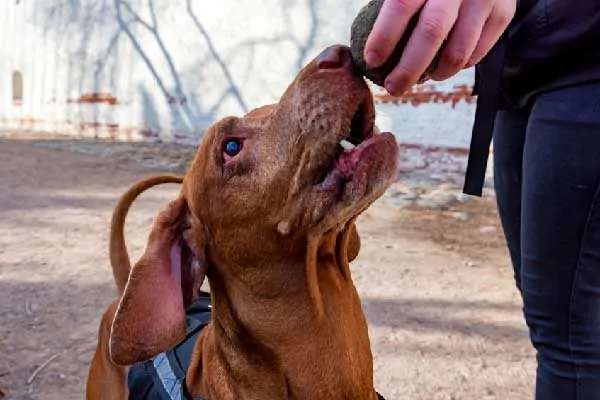
Diet is no.1 when it comes to caring for a hunting dog breed. As Vizslas are highly energetic, you need to spend at least two hours working them rigorously, whether it is training or exercise. And after that, they will need a high-calorie diet that relaxes their muscles and strengthens their bones.
What to feed your Vizsla?
High-quality dog food, both dry and gravy, is recommended. You can also serve them raw minced meat once or twice a week. They also love to munch on vegetables like carrots. During the growing period, you can stick to 3-4 cups of dog food divided into two meals daily. Snacks and treats are separate.
Vizsla Overweight issues?
It is important to keep your Vizsla in good shape. Measure the quantity of food you are giving to your dog and regularly weigh your dog. Healthy food with the right proportion of exercise will keep your dog in shape.
Vizsla Dogs Grooming

Grooming is one aspect that you don’t have to worry about in Vizslas. They are incredibly easy to groom and don’t require much attention due to their short coat.
Vizsla Brushing
Brushing is important once a week. You can use a rubber brush to take out whatever shedding they have. (they shed less)
Vizsla Nail trims
Nails can grow quickly in Vizslas. Trim their nails once a month. The best way to realize that your dog’s nails have gotten bigger is when you hear the clicking sound on the floor when they walk.
Vizsla Frequent vet visits
Apart from getting your Vizsla recommended shots and vaccinations, it is important to visit the vet once every six months for a normal checkup to ensure the health of your dog.
Things you might not know about Vizslas

If you have finally decided to own a Vizsla, then there are some facts about the breed that you must know.
- V for VELCRO – they are popularly known as VELCRO dogs because they will follow you around the house, making sure you are never alone.
- They are all redheads – they have distinctively beautiful coloring. The purebred will boast warm russet tones with some golden hue. They have red skin around the eyes and a red nose.
- Vizsla has numerous meanings in Hungarian – in Hungarian, Vizslas also means deerhound, retriever, and beagle.
- Wirehaired Vizslas – a separate breed? – Wirehaired Vizslas a distinct species created using Vizslas and German wirehaired pointers for winter hunting.
- Were used to create German shorthaired pointer and Weimaraner breeds – Vizslas lend their traits to the creation of German shorthaired pointer and Weimaraner breeds.
- Vizslas are excellent swimmers – they can swim with you in the oceans and rivers, but since they don’t have any insulating undercoat, avoid swimming when it is cold outside.
- They are incredibly sensitive and gentle souls – they need consistent training with lots of treats, belly rubs, and snuggles. Don’t use harsh training measures.
- Their eyes are blue when they first open – they are born with bluish-green eyes. As they get older, it turns to grey, and when they reach maturity, the color of the eyes turns to a warm yellow-brown.
- Are among the top 10 fastest dog breeds! – they can run at a top speed of 40 miles per hour.
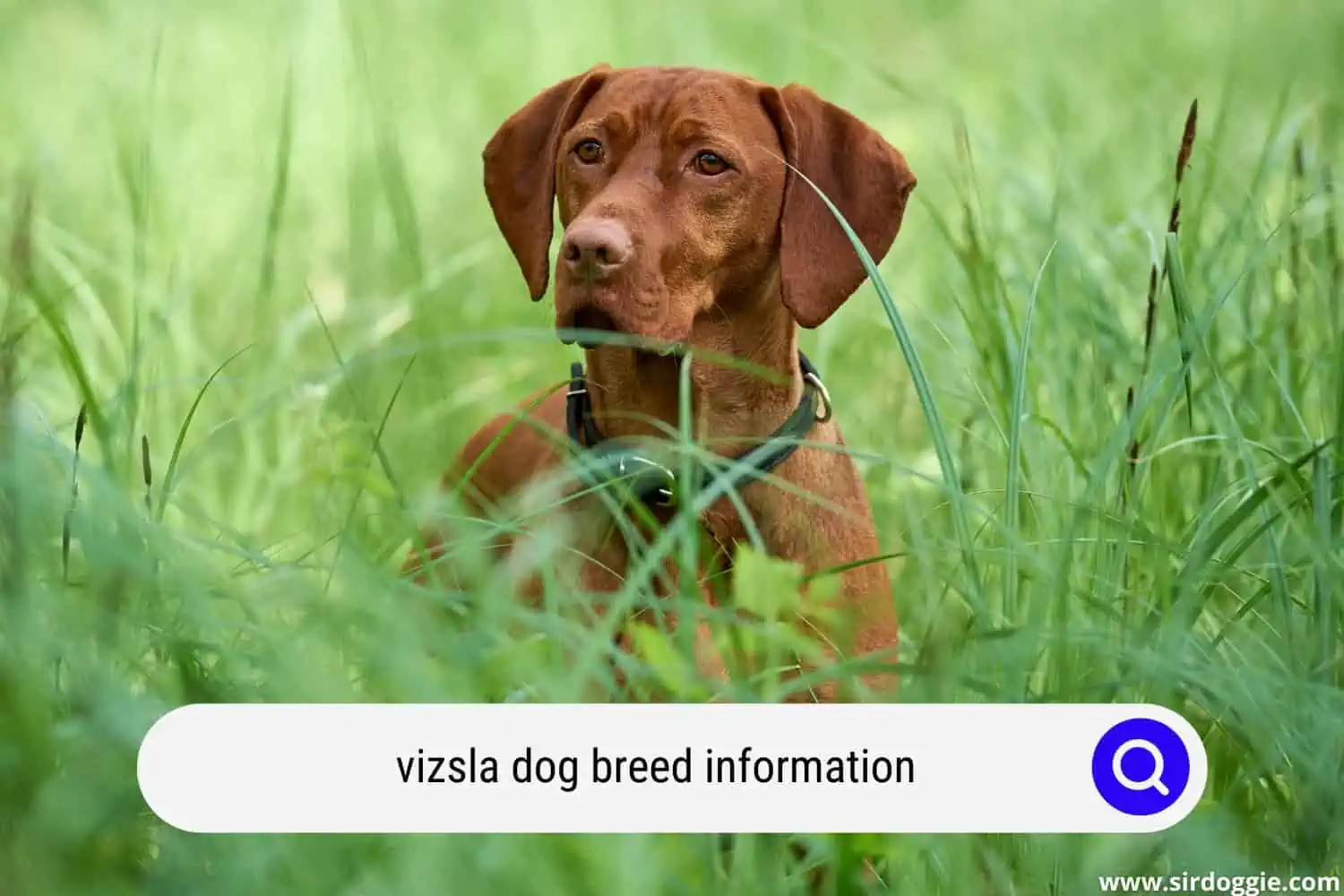
Introducing Vizsla Pup to your House for the First Time
When you are introducing Vizsla pup to your family and possibly other pets, it is important to keep the following things in mind –
- Take your time and make sure that only a few people can access them at once. Crowding the pup may frighten it
- Start kennel or crate training immediately to give the pup its own personal space
- Keep the kitties away (for a while) as the cat may prove to be aggressive toward the pup
- Introduce to other dogs (with a walk outside your home)
- No babies – start with adults, teenagers, toddlers, and then infants
- Monitor their daily interactions
Who’s the Best Human for a Vizsla?
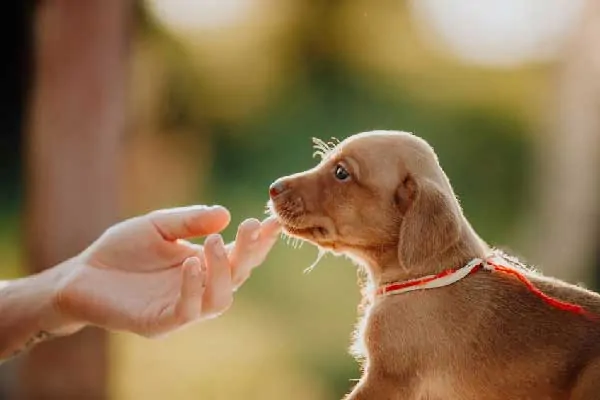
After reading this handbook, you must have clearly realized whether or not the Vizsla dog breed is suitable for you. If you are looking for a dog breed that you can leave at home alone while you go to work, then a Vizsla is not for you.
This dog breed is for people who love leading an active lifestyle, like hunting, hiking, swimming, training, and more. Vizslas love to be outdoors, and as an owner, you should provide them with everything that keeps them healthy both physically and mentally.

Family Dog Expert Author
Hi there! I’m Stuart, a devoted dog lover and family dog expert with over a decade of experience working with our furry companions. My passion for dogs drives me to share my knowledge and expertise, helping families build strong, loving bonds with their four-legged friends. When I’m not writing for SirDoggie, you’ll find me hiking, playing with my beautiful dog, or studying music.